Time for a bit of a detour, as the Disney Read-Watch pauses to watch—not read—a couple of Disney Christmas shorts loosely based on literary sources: Mickey’s Christmas Carol and The Gift of the Magi. And for those of you thinking that, given the film coming up next in the Read-Watch, we should really be discussing Beauty and the Beast: An Enchanted Christmas instead, thing is, I checked, and it turns out, that film was never ever made, never ever existed, and was never even thought of, no matter what Google, Disney, IMDB, and your own DVD collection might be telling you.
Never existed. AT ALL.
So that’s that.
Now, Mickey!
For Disney, the early 1980s were not just about the difficulties of keeping a demoralized animation department together during the long gaps between films, or struggling over the problems of bringing The Black Cauldron to life. Sometimes, Disney executives ordered a new cartoon short or two. Most of these were intended to accompany re-releases of old Disney films, since executives had found that attaching new cartoons to the old films helped persuade families that sure, they did need to go see Cinderella again.
(Even if, as in the case of a rather disastrous mid 80s release of Snow White and the Seven Dwarfs, Disney chose to “update” the film’s aspect ratio, cutting off about 20% of the animation, including adorable little animated birds and squirrels.)
Such was the case for Mickey’s Christmas Carol, timed to accompany a new release of The Jungle Book in the United Kingdom and The Rescuers in the United States. But this short was a bit more than that: it was the first Mickey short produced after Walt Disney’s death. Mickey Mouse had, of course, been in other hands even while Walt Disney was alive—many of the Mickey Mouse cartoons were written and directed by others, and Jimmy MacDonald had voiced Mickey from 1947 to 1977.
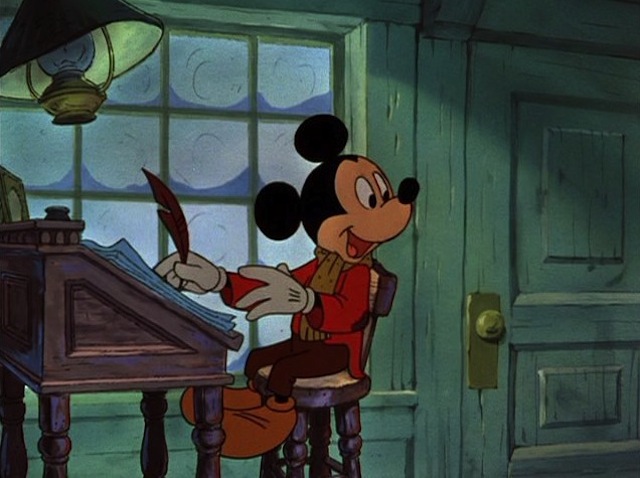
Sound effects editor Wayne Allwine, who had been working for MacDonald in the sound effects department for years at that point, auditioned for the role right after MacDonald quit, partly out of admiration for his boss, and mostly out of a genuine love for Mickey Mouse. He got the part, becoming the official voice of Mickey Mouse from 1977 until 2009. In 1991, he married Russi Taylor—who voiced Minnie Mouse. Disney publicity material claims that three of their four children also learned to make their voices sound like Mickey.
(Incidentally, the main formal recognition Allwine received while voicing Mickey Mouse actually came from a technical Emmy Award earned while working with Steven Spielberg on Amazing Stories, a Universal production broadcast on NBC, although he and his wife were eventually named Disney Legends.)
Allwine was delighted, if a bit intimidated, by the idea of a new Mickey Mouse cartoon. Up until that point, most of his vocal work for Mickey had consisted of very brief segments for The New Mickey Mouse Club and some theme park attractions. As it turned out, however, he had only a minor role in the final cartoon. As one of Disney’s two major corporate symbols, Mickey could not, alas, be a mean Scrooge, or even a mean Scrooge who eventually reforms. That role was given, naturally, to Scrooge McDuck. Mickey, equally naturally, became Bob Cratchit—wearing a red coat as a nod to Mickey’s traditional red shorts.
This casting did create one moment that I, at least, found just a touch awkward: Scrooge, as we found out, once fell deeply in love with young Isabelle, played, I’m very sorry to say, by Daisy Duck, the lady love of Donald Duck. I would ignore this, except for two small issues: one, Donald Duck appears in this film, as Scrooge’s nephew Fred, which means that YES, SCROOGE IS HITTING ON HIS NEPHEW’S GIRLFRIEND while his three great-nephews decorate a Christmas tree in the background, and two, THIS IS NOT EVEN CLOSE TO THE MOST DISTURBING INFORMATION ABOUT DISNEY DUCKS TO APPEAR IN THIS POST. NOT EVEN CLOSE.
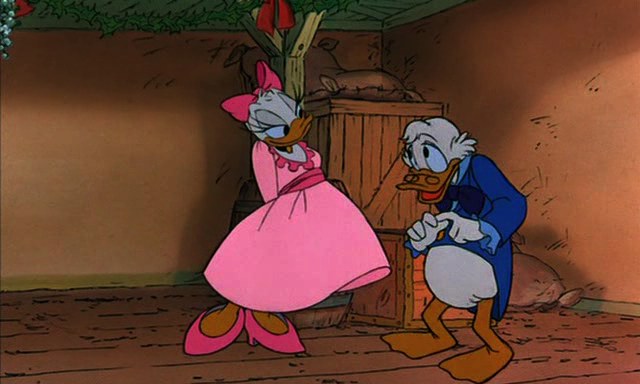
So, I’m disturbed.
To counter that, casting Mickey Mouse as Bob Cratchit meant casting the most adorable little Mickey as Tiny Tim. In general, I can’t tolerate Tiny Tim—even when played by little Robin in the Muppet version—but in this case, Tiny Mickey Tim is so adorable I almost want to get him as a toy. Almost.
It helps that Tiny Mickey Tim, like the rest of the characters, is not on screen that long: A Christmas Carol is not exactly a long novel, but Mickey’s Christmas Carol shortens it still further, crushing it into a 22 minute piece. (Since the time of the silents, most A Christmas Carol adaptations have clocked in at around one hour or more.) Some of that is dedicated to cameo appearances from various Disney characters. Most of them stay in the background, but a few have speaking roles—Rat and Mole from The Adventures of Ichabod and Mr. Toad, Jiminy Cricket from Pinocchio, for instance, but even Donald Duck only gets a few lines.
Also not really in the cartoon: most of Dickens’ social commentary. Oh, certainly, Rat and Mole do point out that they are collecting for the poor, but Scrooge’s famous riposte that the poorhouses are already around, thanks, is eliminated, replaced by a monologue from Scrooge McDuck that really, his failure to give Rat and Mole money for the poor is helping keep Rat and Mole employed, so this is all a good thing—for Rat and Mole. The shivering children that Scrooge sees thanks to the Ghost of Christmas Present never appear. We do get an acknowledgement from Goofy—playing Marley—that his selfishness and greediness force him to wear chains for all eternity—but since this is Goofy, he seems, for the most part, kinda ok with the whole deal, a couple of attempts to terrify Scrooge aside.
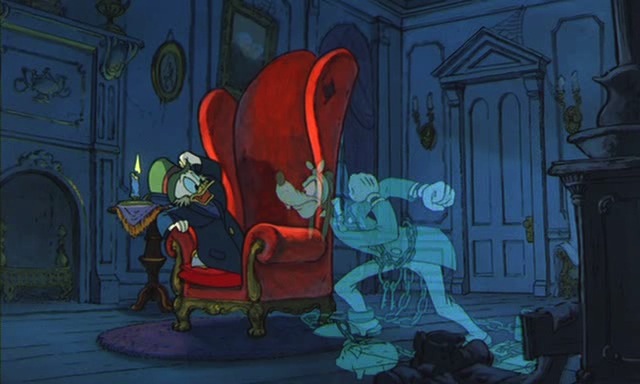
Which means, also missing: any hint of why Scrooge became Scrooge, or any real sense that he is changing, ghost by ghost. It’s mostly greedy miserly Scrooge, quick ghosts, and happy Scrooge. But it’s not too far off from the novel, and if you just want a quick taste of Dickens, this might be your film.
It’s also a solid example of Disney xerography, just a few years before animators would start to abandon the technique. Mickey’s Christmas Carol was produced on the cheap, and this shows in the simplistic, hastily created backgrounds, but by this point, the xerography technique could at least ink in colored lines, creating softer, smoother animated characters. It was one of the last pieces of major Disney animation produced entirely by hand: even as cleanup artists worked on the film, animators were already considering the possibilities of using computers to help with some of the trickier parts of The Black Cauldron.
Which leads me to a trivia note: Mickey’s Christmas Carol is currently the only Disney animated film, short or long, to list John Lasseter—remember him, just mentioned last time?—in the credits.
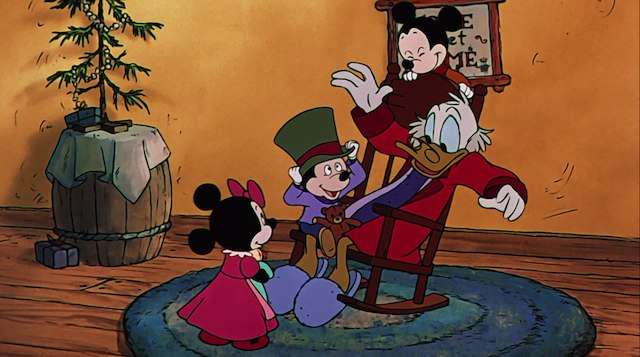
Mickey’s Christmas Carol was later inserted into Mickey’s Magical Christmas: Snowed in at the House of Mickey Mouse, a compilation of Disney Christmas shorts that I have never been able to watch beyond the first fifteen seconds, entirely because Hades makes a cameo appearance in those first fifteen seconds, leading me to the unanswerable question: what in HADES is Hades doing in a Christmas film?
(The answer, in case you are wondering, is that Mickey’s Magical Christmas is a spinoff from Disney’s House of Mouse series, where various Disney characters—including Hades—stop in for a bit of fun at Mickey Mouse’s dinner theatre, “fun” in this case meaning “watch a cartoon.” The show in general was a mildly clever way of reusing old Mickey Mouse shorts and cross-marketing Disney characters to small children, but I still don’t see Hades heading to a Christmas celebration of any sort at Mickey Mouse’s place. Moving on.)
The short can also be found in various Disney DVD collections. I do have to warn you against the 2013 Blu-Ray edition, which changes the aspect ratio again (WHY DO YOU DO THIS TO ME DISNEY, WHY?) cropping off some of the animation, creating more than one strange moment where Scrooge, apart from all of his other problems, has no feet. Disney apparently does plan to release the short again in its correct aspect ratio; in the meantime, you can watch it on Mickey’s Magical Christmas, which I understand does have the correct aspect ratio. (Can’t personally verify this, because, Hades, remember?)
The short was successful enough that in the late 1990s, still cresting a wave of popularity with Disney animation, and wanting to capitalize on the increasingly popular Christmas events at the various Disney parks, Disney ordered the animation department to produce a direct to video Mickey Mouse Christmas special. The animation department responded by producing three Christmas shorts, collected into Mickey’s Once Upon a Christmas (1999):
Donald Duck Stuck on Christmas, wherein we discover that ducks eat turkey for Christmas dinner, something made NO LESS DISTURBING when, later in the short, a turkey, who turns out to be a neighbor, JOINS THEM FOR DINNER. YES. DAISY DUCK SERVES UP HER NEIGHBORS FOR CHRISTMAS DINNER I hope you all have a wonderful holiday.
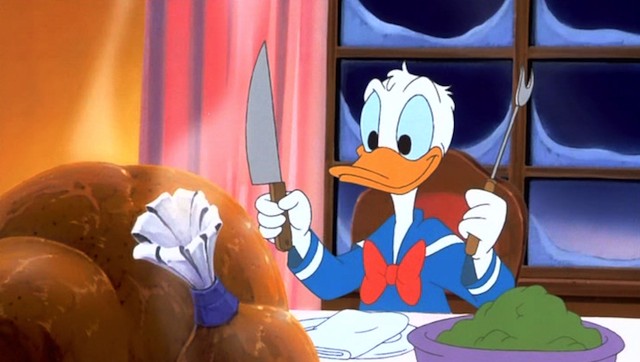
A Very Goofy Christmas, wherein I discovered that Goofy has a kid called Max, something I never knew before, and that allowing Goofy into a mall is a very bad idea, something I’d suspected before, but now could verify for myself.
The Gift of the Magi, wherein we all learn that little Figaro, the adorable kitten from Pinocchio, is still living with Minnie Mouse, which I must say seems safer than hanging out with Geppetto, what with the woodworker’s tendency to end up in the belly of whales and all that.
Ok, there’s a bit more to all three shorts than this. Donald Duck Stuck on Christmas is a variation on the old “be careful what you wish for,” where, after a careless wish (PROBABLY CAUSED BY FORCING THEM TO EAT ONE OF THE NEIGHBORS, DAISY) Donald’s three nephews find themselves having to relive Christmas over and over again. It swiftly becomes a nightmare until the three finally learn the True Meaning of Christmas (which SHOULDN’T INCLUDE EATING THE NEIGHBORS, DAISY!)
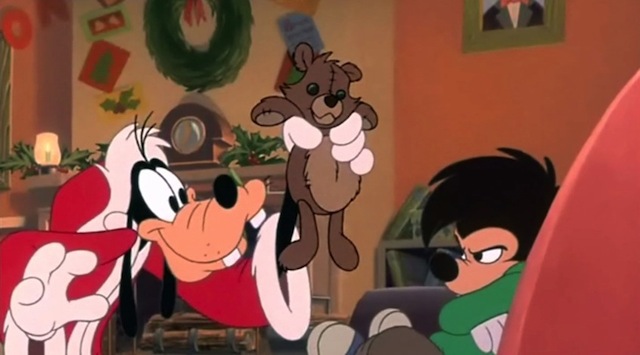
A Very Goofy Christmas is a bit harder to figure out: it’s more or less about Max, who desperately wants to believe that Santa exists and will bring him a gift, only to find out that Goofy has been—gasp—impersonating Santa Claus. (Goofy calls him Santy, which becomes increasingly more irritating as the short continues.) Only, as it turns out—Goofy believes in Santa Claus as well, and, well, Santa shows up. Which is all great and all, but if Santa exists, why do the poor kids down the road only get presents from Goofy, and not Santa? I am troubled.
The Gift of the Magi, as you might guess from the title, is loosely based on O. Henry’s well known story, “The Gift of the Magi,” although, since this is a Mickey cartoon, rather more time is spent on things like letting Mickey play harmonica with the band, various hijinks from Pluto, and cameo appearances from a number of other characters from the old Mickey cartoon shorts. Mickey wants to buy Minnie a gold chain for her grandfather’s watch, and figures that with enough decent tips, he can afford it. Minnie wants to buy Mickey a nice case for his harmonica, and figures that with the upcoming Christmas bonus from her job, she can afford it. Alas, a rather nasty incident at his job selling Christmas trees means that Mean Pete takes Mickey’s bonus away from him, and Minnie’s bonus turns out to be, tragically enough, fruit cake. Naturally, Mickey sells his harmonica to pay for Minnie’s chain, and Minnie sells her grandfather’s watch to buy Mickey the harmonica case. HUGS ABOUND.
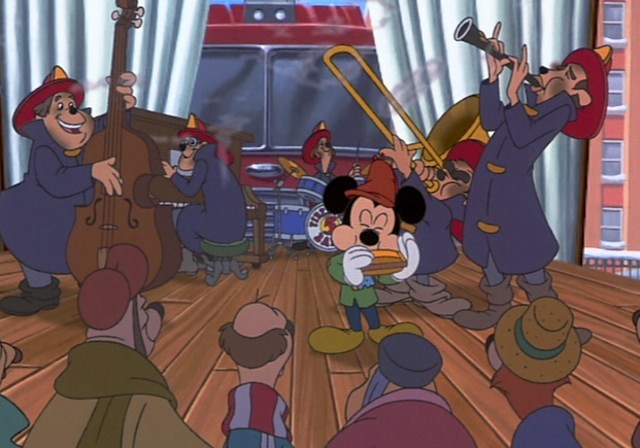
Despite the hugs, the short has some rather dark undertones. Mickey, for instance, earns just enough money to buy that chain for Minnie—only to lose it moments later when he tries to do something nice for a poor family on Christmas Eve. Mickey has been told by his boss, Pete to sell some giant Christmas trees. Since it’s Christmas Eve, this is absolutely positively last day that the giant trees can be sold, and Pete is desperate to sell them. Since the family is poor, they can’t really afford a giant tree—and they can’t disappoint their kids either. They prepare to shell out a down payment—only to be saved by Mickey, who pulls out a tiny tree, hidden by Pete, that does fit their budget. The family is delighted. Pete is not, taking the difference in profits out of Mickey’s earned tips, leaving the poor mouse too broke to buy Minnie her chain.
The cartoon has some glorious fun punishing Pete for this—his pants, and then his entire Christmas tree lot, go up in flames, costing him all of his money—but still, it’s a rather odd choice to make in a Christmas feature: do something nice for people, and find yourself broke and having to sell off your harmonica. Sniffle. Especially since Mickey has earlier used the harmonica to raise money for a toy drive. Yikes. On the other hand, Mickey does look absolutely thrilled when he realizes that, oh yes, he can buy Minnie that chain after all, and he does get a hug, so….I guess we’re happy about this?
Perhaps because this cartoon is clear to place the blame on the bosses, not Mickey and Minnie.
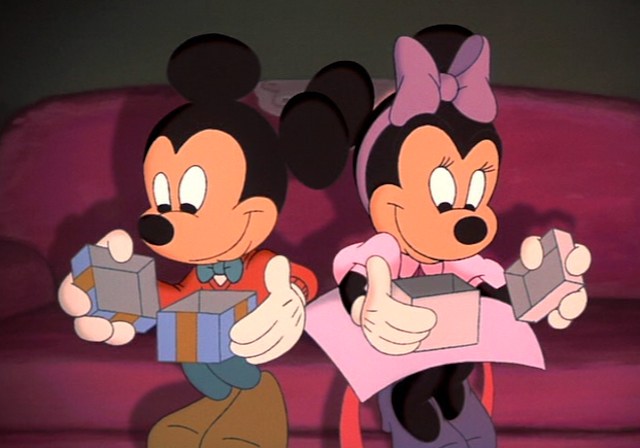
Or perhaps because something had changed between 1983, when Mickey Mouse, as Bob Cratchit, ended the film rewarded with a raise and a promotion for all his hard work (thanks, Christmas ghosts), and 1999, when Mickey ended the film rewarded with a hug from Minnie, after his boss burned his workplace down. Even right after a major recession, in 1983 workers could still hope to remain at the same firm for decades. By 1999, this hope had largely vanished. After all, the very voice of Mickey Mouse sometimes did a job or two for Universal. And John Lasseter—remember him?—was, at this point, over at Pixar.
Or perhaps Disney just wanted to showcase different aspects of Christmas.
You decide.
Mari Ness lives in central Florida.










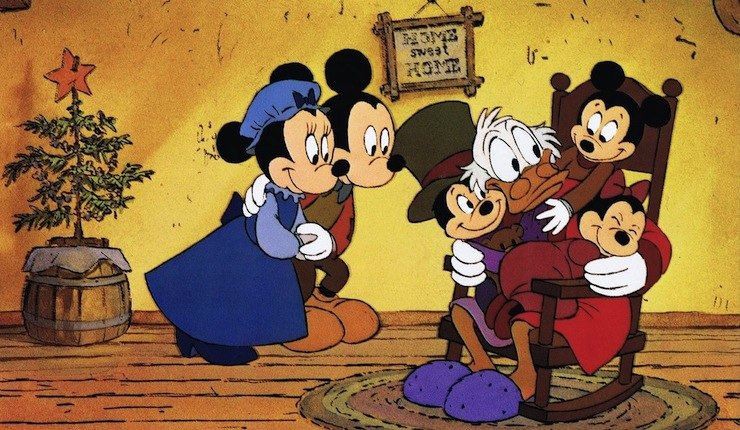
I love Mickey’s Christmas Carol. As a kid, our VHS copy (don’t remember if it was bought or recorded off TV) had a few shorts in front of it: one with Chip n Dale in a Christmas tree, and one with Donald and his nephews having an all out war of a snowball fight. It’s great!
Over Christmas we watched a DVD version that included the recent Yodelberg short.
There’s one moment toward the end of Mickey’s Christmas Carol that I’d like explained. After the three visits, when Scrooge first goes outside there are a couple of little cat hooligans being chased by a pig with a gun. They all run right by him. True story. I’d really like to know what that was about.
“it’s a rather odd choice to make in a Christmas feature: do something nice for people, and find yourself broke and having to sell off your harmonica.” – in some ways, this tone is incredibly similar to the tone in an other Christmas classic, It’s A Wonderful Life. Poor George Bailey can never really get ahead. (This is one of my favorite movies of all time; so I’m not dissing it. It’s about doing good, and suffering and doing good anyway ;) )
THIS IS NOT EVEN CLOSE TO THE MOST DISTURBING INFORMATION ABOUT DISNEY DUCKS TO APPEAR IN THIS POST. NOT EVEN CLOSE. – hahaha, this made me laugh :)
So I have to ask (having never seen it) – why the animus towards a movie that doesn’t even exist?
Living with a mouse might be safe for the kitten, but not for the mouse. Is it not turning into a Tom and Jerry story because that’s not from Disney?
I remember I liked Mickey’s Christmas Carol as a kid, but when I came back to it as an adult, I felt it took out too much of Dickens’ message for classic Disney humor. Even Mr. Magoo didn’t do that, and the Muppets found a surprisingly good balance.
Goofy has had a couple of kids. He had a son and a wife in some of his shorts were he was playing an every man. Max is from his ’90’s TV show Goof Troop. Max is also in A Goofy Movie.
We used to own Belle’s Enchanted Christmas…
maybe it was all a dream?
The moment of reveal for the Ghost of Christmas Yet to Come in Mickey’s Christmas Carol freaked me out when I first saw it as a five-year old. No wonder WatchMojo ranked it as one of the darkest Disney moments.
“Why yours, Ebeneezer.”
Disney is frequently disappointing. They even falsely title some of their books. I remember being given a book once, titled “Cooking with Mickey Mouse”. I read it from cover to cover more than once, and still could not find a recipe for “Chilli con Mickey”, and absolutely nothing about stir-fried Mickey, let alone deep-fried Mickey and Chips. Nada. Absolutely nothing!
I have “Mickey’s Christmas Carol” on a DVD collection titled “Classic Holiday Stories” (with “The Small One” and “Pluto’s Christmas Tree,” the Chip ‘n’ Dale one), volume 8 of Walt Disney’s Classic Cartoon Favorites. I can’t speak to the aspect ratio, though.
I find Mickey’s Christmas Carol quite thin. The only moment I remember delighting in when I first saw it (on the big screen, when it came out, when I was already an adult) is the moment where the ghost of Christmas Present (the giant) picks up the street lamp and uses it as a flashlight. @@.-@, I agree that both Mr. Magoo and the Muppets do a far better job on the Carol.
I am not bothered, though, by the fact that Daisy plays Scrooge’s love-interest. There are scads of European Disney comics stories where the Disney characters take the roles of characters in a famous piece of literature, and it’s clear in that “literary parody” genre of comics that the characters are not bound by their relations in “real life.” Daisy, Donald and Scrooge are the actors, here, playing the parts on screen.
It is, of course, amusing that Scrooge McDuck, who was originally named (by Carl Barks, his creator) after Dickens’ miser, here gets to appear as the original Scrooge.
I agree that Goofy was not a good choice for Marley; he’s far too sunny and happy-go-lucky. Probably the animators just felt they had to use Goofy somewhere in the story. If the American audience at the time had been more up on the Disney comics (as, say, Scandinavians and Italians continued to be), there is an ideal candidate for a character to play Scrooge’s deceased partner: Scrooge McDuck’s South African doppelganger and fellow gazillionaire, Flintheart Glomgold (also created by Carl Barks).
On the ducks eating turkey: In the cartoons and certainly in the comics, the Disney Ducks are far more anthropomorphized than, say, Daffy and Bugs. They are basically humans who happen to look like ducks. They live in people houses, they work at people jobs or go to school, they need airplanes to fly, they eat people food. In the classic Carl Barks comics, the Ducks certainly eat turkey at Thanksgiving and Christmas. They do not, however, invite turkey neighbors to the feast. I agree entirely that that was a big mistake on the cartoonists’ part.
Oh, and another sign of the level of anthropomorphism of the Disney Ducks and Mice (in contrast to Bugs & Daffy)–they keep dogs and cats as pets. Mickey and Pluto, Minnie and Figaro, Donald and Tabby, Huey, Dewey & Louie and Bolivar. Those animals sometimes are themselves anthropomorphized to the extent of thinking intelligently (in comics’ balloons) or winning games of checkers, but they do not talk or wear clothes. We won’t discuss the pet-like animals who blur this line, who generally enter the comics from the cartoons or animated movies–like those annoying mice from Cinderella, Gus and Jaq, who somehow regrettably end up on Grandma Duck’s farm, wearing clothes and talking away. But *not* in stories by Carl Barks!
My niece rewatches Donald Duck stuck on Christmas, on Netflix, every single weekend, so I know how Donald’s nephews feel having to relive the same day over and over again.
Wait, there was a post last week? What’d I miss? The last post I see is The Rescuers Down Under, on December 17th.
How about we all mutually agree that NONE of the cheapquels ever existed, and that IMDB is somehow providing us with a portal into some horrifying alternate universe that was vanquished but we still have scarring memories? Think balefire or the plot of Back To The Future II. Yeah, I can be happy with that.
[Exemption granted for the Hercules TV show. And it’s a debatable point whether Tinker Bell exactly counts as a cheapquel. But nothing else ever happened.]
@13 SunDriedRainbow
This post was meant to run on Christmas Eve, but due to a mix-up was held back until after the holiday. Mari’s reference to John Lassater appearing in the column “last week” (now edited to “last time” for clarity) does point to The Rescuers Down Under, which contains lengthy computer assisted animation sequences. Sorry for the confusion!
I enjoyed your write-up. I’ve never actually seen Mickey’s Christmas Carol, but I do have very clear memories of listening to a vinyl LP that was, I think, entitled A Disney Christmas Carol or something. It was longer than 22 minutes, and that it preceded Mickey’s Christmas Carol by about a decade, if this wiki entry is correct. It has lots of fun songs and, I think, a bit more of Dickens’ original social concerns than the cartoon apparently has.
My favorite moment in the whole thing – is it preserved in the cartoon? – is when Goofy as Marley cries about being “doomed, doomed for all eternity! Maybe even longer.”
@@@@@16. MikePoteet
Yes Mike, that line is definitely in there. From a Dickensian perspective, maybe Goofy wasn’t the right choice. From a purely entertainment perspective, he steals the show.
Werechull – They’re very hard to identify because a) it’s a blink and you’ll miss it moment, and b) they only appeared in a couple of early, pre World War II cartoon shorts, but those aren’t cats. Those are two of the Three Little Wolves (nephews of the Big Bad Wolf), chased by Practical Pig with a gun.
Lisamarie – Answering that question would require acknowledging the existence of that film, which I don’t.
Saavik – I was planning on giving Daisy a pass for the turkey thing until the turkey showed up for Christmas dinner, ready to eat ham. At that point I got very disturbed.
SundriedRainbow – Whoops, sorry for leaving that reference in there – this post was originally planned for Christmas Eve, and when I checked it earlier this week, all I noticed was the Beauty and the Beast references, not the John Lasseter references.
Everyone – I’m certainly willing to agree that most of the Disney sequels never really existed, though – fair warning – I’ll be referring to a few of them as we go on.
@15, @18, phew! Glad I didn’t miss a post, this is my favorite tor.com column. Thanks for explaining!
@@@@@18. MariCats
Mari, thanks for that! I just looked up the video (“Three Little Wolves: https://www.youtube.com/watch?v=x-fRHN8te30). That was amazing! A mashup of 3 Little Pigs, The Boy Who Cried Wolf, Anti-German Propaganda, and Itchy and Scratchy.
My daughter watches this on Netflix all the time!!!! It ranks very high on the parental headache list. My question is why is Prince Adam still a beast when he’s hanging out with Belle at the House of Mouse? Also this selection is almost always followed by the collection of shorts featuring the 3 little pigs and the Big Bad Wolf discussed in the comments above. It might be even higher on the headache scale due to the fact that the “Whose afraid of the Big Bad Wolf” song becomes impossible to get out of your head. I’m whistling it now and I haven’t see it for days!!
You write about Disney cartoons and are surprised to learn about Goofy’s son max from a 1999 short when he was one of the stars of the 92-93 Goof Troop animated series? That’s odd.
I mean, you might have not watched Goof Troop, but I find it very surprising that you had never even seen it by accident or learned about Max on the web…
As a mammal who eats other mammals (damn now I want a bacon cheeseburger), I have no problem with a duck eating turkey. However, inviting your turkey neighbor over to eat turkey for dinner is a faux pas of the highest magnitude.
We’re mammals who eat other mammals, but we don’t (except in some parts of the world) eat other primates.
Saavik: If they were using the comics, they could have also used Glitterin’ Goldie as Scrooge’s old flame.
Regarding Hades, maybe he celebrates the winter solstice because that’s when his wife comes back to the Underworld, at least in some versions of the myth.